| |
Koizumi Kishio’s 1940 Annotations on
“100 Views of Great Tokyo in the Shōwa Era”
Translation provided by James T. Ulak from Koizumi’s original
woodblock print charts containing print titles, dates, and comments
|
|
|
 1. 1. |
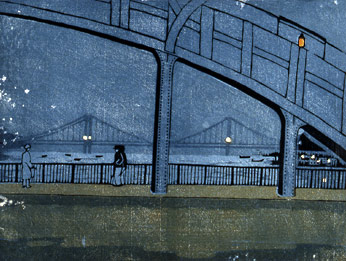
|
 “City Hall was very proud of the rapid construction of bridges that form the base of the recovery.” “City Hall was very proud of the rapid construction of bridges that form the base of the recovery.”
Eitai Bridge and Kiyosu
Bridge (#1), September 1928 | |
|
 2. 2. |
  “At least Shinobazu Pond could be rendered as it was in the old days.”
“At least Shinobazu Pond could be rendered as it was in the old days.”
Shinobazu Lake in the
Spring Rain (#2),
April 1929 |
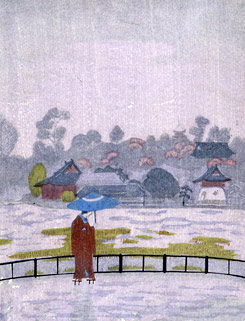 |
|
|
 3. 3. |
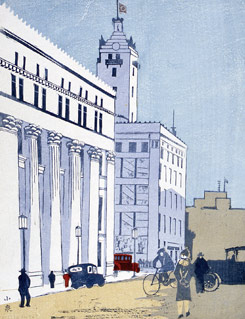 |
 “I had heard that a single column on the façade of the Mitsui Bank cost 20,000 yen to build. This was also a time when red customer service cars were offered by Mitsukoshi Department Store.” “I had heard that a single column on the façade of the Mitsui Bank cost 20,000 yen to build. This was also a time when red customer service cars were offered by Mitsukoshi Department Store.”
Mitsui Bank and Mitsukoshi Department
Store (#3), April 1930 [May 1929] |
|
|
 4. 4. |
  “This work was well received and its ‘left wing’ style was a source of comment.”
“This work was well received and its ‘left wing’ style was a source of comment.”
Senju Town with Storage Tanks (#4),
ca. June 1929 |
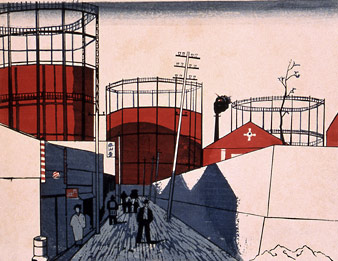 |
|
|
 5. 5. |
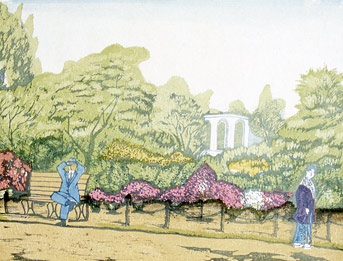 |
 “The fresh green leaves and blossoming azaleas were strikingly beautiful. The addition of a few human figures was oddly effective.” “The fresh green leaves and blossoming azaleas were strikingly beautiful. The addition of a few human figures was oddly effective.”
Hibiya Park with Fresh Leaves and Azalea
Blossoms (#5), July 1930 [May 1930] |
|
|
 6. 6. |
  “In the morning and evening the drawbridge was in the down position to accommodate freight trains.”
“In the morning and evening the drawbridge was in the down position to accommodate freight trains.”
Drawbridge at Shibaura (#6), September 1930 |
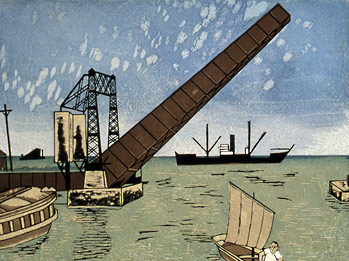
| |
|
 7. 7. |
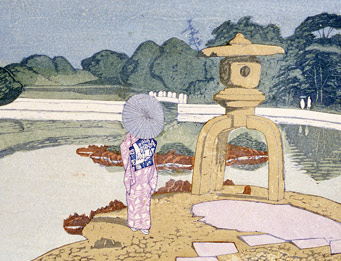
|
 “This park was once the location of an imperial villa. Now houses built on a nearby landfill obstruct the view.” “This park was once the location of an imperial villa. Now houses built on a nearby landfill obstruct the view.”
Hama Imperial Gift Park at Shiba (#7),
September 1930 [October 1930] |
|
|
 8. 8. |
  “This is an unusual view from the old days. I wonder if it still exists?”
“This is an unusual view from the old days. I wonder if it still exists?”
Dye Factory at Waseda (#8),
November 1930 |
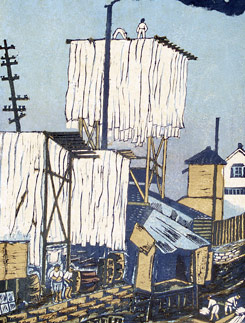 |
|
|
 9. 9. |
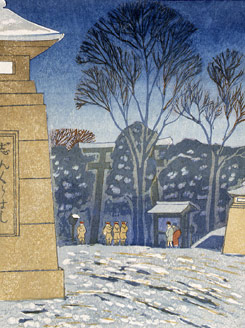 |
 “I select this scene as appropriate for New Year. It was snowing on January 1st.” “I select this scene as appropriate for New Year. It was snowing on January 1st.”
Snow Covered Meiji Shrine Bridge
at Dawn (#9), ca. January 1931 |
|
|
 10. 10. |
  “The statute of the Kannon Bodhisattva survived the earthquake, but only a few of the shops on Nakamise remained.”
“The statute of the Kannon Bodhisattva survived the earthquake, but only a few of the shops on Nakamise remained.”
Nakamise Street Viewed from Nioømon
Gate [Asakusa] (#10), February 1931 |
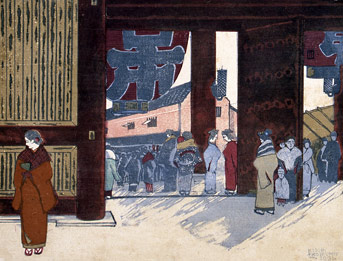 |
|
|
 11. 11. |
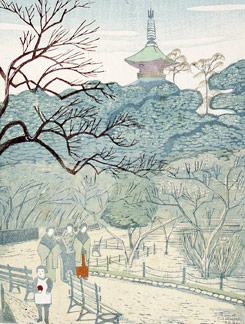 |
 “Plums blossom while it is still cold. It doesn’t seem as if many have bloomed.” “Plums blossom while it is still cold. It doesn’t seem as if many have bloomed.”
Shiba Park with a Pagoda and Plum
Blossoms (#11), March 1931 [February 1931] |
|
|
 12. 12. |
  “An evening during the era of
“An evening during the era of
dazzling illumination.”
Night View of Ginza in the
Spring (#12a), March 1931 |
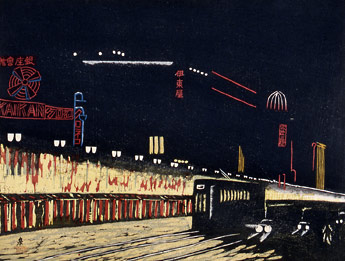
| |
|
 13. 13. |
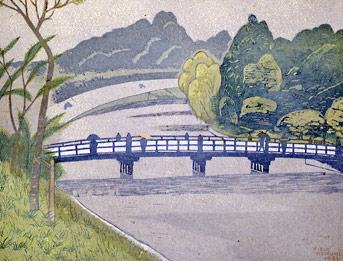
|
 “The view at Benkei Bridge is beautiful in any season. This scene depicts a spring rain after the blossoms have fallen.” “The view at Benkei Bridge is beautiful in any season. This scene depicts a spring rain after the blossoms have fallen.”
Benkei Bridge in May (#13),
June 1931 [May 1931] |
|
|
 14. 14. |
  “The first version of this print showed the fountain. This is a revised edition.”
“The first version of this print showed the fountain. This is a revised edition.”
Hamamachi Park (#14r),
March 1940 [February 1940]
Hamamachi Park in the Spring
Snow (#14), July 1931 |
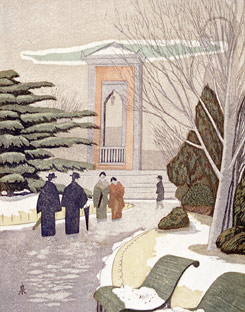
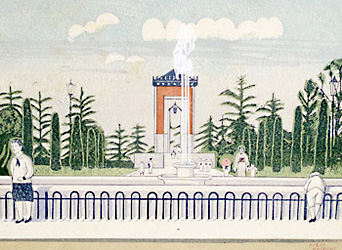 |
|
|
 15. 15. |
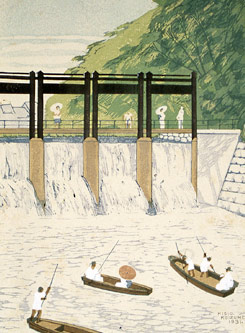 |
 “In summer people enjoy being near the water. Pleasure boats were also available.” “In summer people enjoy being near the water. Pleasure boats were also available.”
Waterfall at Sekiguchi (#15),
August 1931 [July 1931] |
|
|
 16. 16. |
  “Vegetables for all of Tokyo were distributed from this place.”
“Vegetables for all of Tokyo were distributed from this place.”
Vegetable Market at Kanda (#16),
September 1931 [August 1931] |
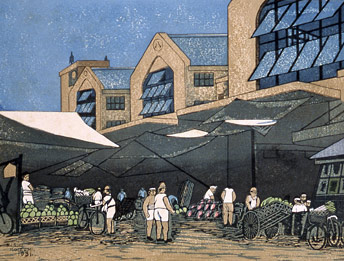 |
|
|
 17. 17. |
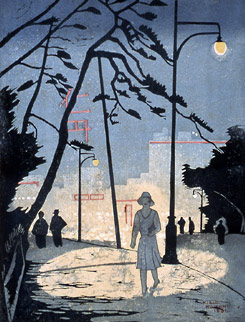 |
 “In the era of the shoguns, the ‘Black Gate’ stood at this site. The remaining pines do not comment on this.” “In the era of the shoguns, the ‘Black Gate’ stood at this site. The remaining pines do not comment on this.”
Yamashita Entrance to Ueno Park (#17),
September 1931 |
|
|
 18. 18. |
  “In this compound in proximity were Omiya Place, residence for Prince Chichibu and a residence for the Crown Prince.”
“In this compound in proximity were Omiya Place, residence for Prince Chichibu and a residence for the Crown Prince.”
Former Imperial Palace at
Aoyama (#18), October 1931 |
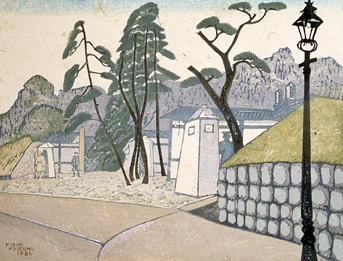
| |
|
 19. 19. |
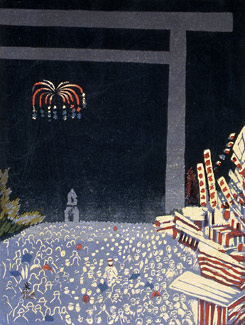
|
 “In the old days one could see a circus, ragtag band of musicians and even moving pictures. There are large festivals here both in autumn and in spring.” “In the old days one could see a circus, ragtag band of musicians and even moving pictures. There are large festivals here both in autumn and in spring.”
Fall Festival at Yasukuni Shrine
(#19), October 1931 |
|
|
 20. 20. |
  “In modern times this ferry crossing was replaced by a modern drawbridge.”
“In modern times this ferry crossing was replaced by a modern drawbridge.”
Kachidoki Ferry at Tsukiji
(#20), November 1931
New Kachidoki Bridge
(#20r), (no date) |
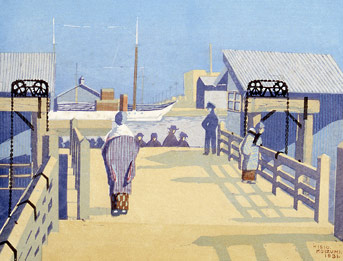
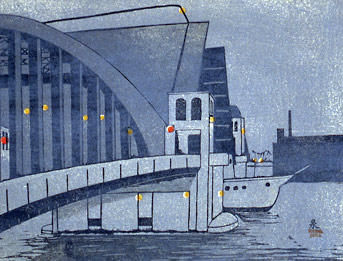 |
|
|
 21. 21. |
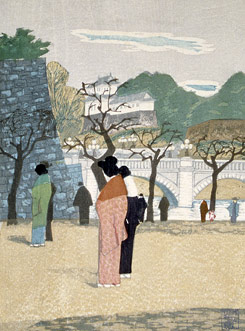 |
 “On this particular New Year’s Day it was so cold that it seemed likely to snow.” “On this particular New Year’s Day it was so cold that it seemed likely to snow.”
Nijuø Bridge on New Year's Day
(#21), January 1932 |
|
|
 22. 22. |
  “The Mitsubishi warehouse is a modern structure. Beyond the bridge is the silhouette of the Shirakiya Department Store. The area of Nihon Bridge at sunset.”
“The Mitsubishi warehouse is a modern structure. Beyond the bridge is the silhouette of the Shirakiya Department Store. The area of Nihon Bridge at sunset.”
Edo Bridge and Its Neighborhood
(#22), February 19321 |
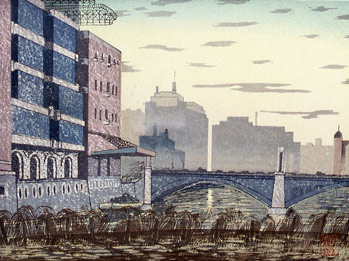 |
|
|
 23. 23. |
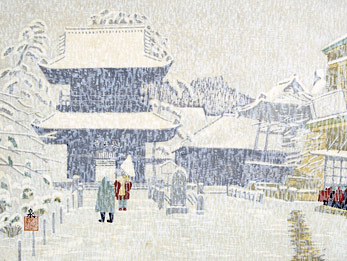 |
 “Seeing this temple in the snow reminded me of the Forty-Seven Loyal Retainers. I used a new technique to render the snow.” “Seeing this temple in the snow reminded me of the Forty-Seven Loyal Retainers. I used a new technique to render the snow.”
Sengakuji Temple in the Snow
(#23a), March 1932 |
|
|
 24. 24. |
  “The Sanno Shrine had a deserted feeling in the early spring. The arrival on an infant for its first blessing adds interest to the scene.”
“The Sanno Shrine had a deserted feeling in the early spring. The arrival on an infant for its first blessing adds interest to the scene.”
Hie Shrine (also called Sanno Shrine)
(#24), March 1932 |
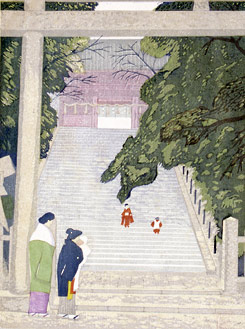
| |
|
 25. 25. |
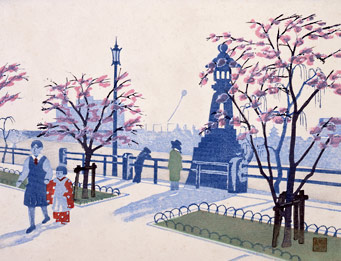
|
 “The Takeya ferry once crossed the Sumida River from here. Now the only reminder of the former look of the old river bank is the stone lantern. Now there is a modern park along the river.” “The Takeya ferry once crossed the Sumida River from here. Now the only reminder of the former look of the old river bank is the stone lantern. Now there is a modern park along the river.”
Kototoi at Sumida Park (#25), April 1932 |
|
|
 26. 26. |
  “This is the modern building where Prince Chichibu once worked.”
“This is the modern building where Prince Chichibu once worked.”
The Third Regiment Headquarters
at Azabu (#26), May 1932 |
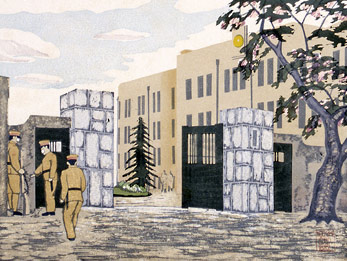 |
|
|
 27. 27. |
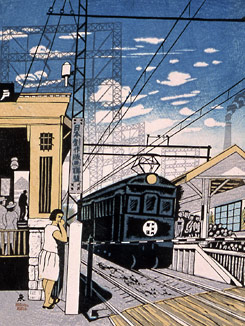
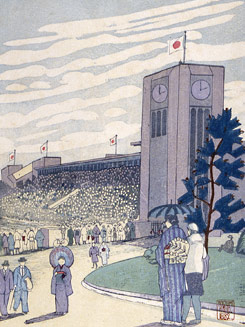 |
 “The steel towers at Ginza Station give an unusual contrast with the suburban setting.” “The steel towers at Ginza Station give an unusual contrast with the suburban setting.”
Togoshi Ginza Station (#27r), July 1940
May Sports Season at Meiji Shrine
Outer Gardens (#27), May 1932 |
|
|
 28. 28. |
  “From olden times this shrine was famous for its wisteria blossoms and for kuzumochi (arrowroot starch cake). But even more famous is the night scene where a bar features famous brands of sake.”
“From olden times this shrine was famous for its wisteria blossoms and for kuzumochi (arrowroot starch cake). But even more famous is the night scene where a bar features famous brands of sake.”
Wisteria Flower and Taiko Bridge at
Kameido Tenjin Shrine (#28r), May 1932
Wisteria Flower and Taiko Bridge at
Kameido Tenjin Shrine (#28), May 1932
|
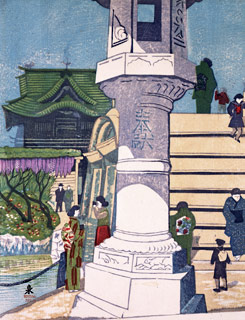
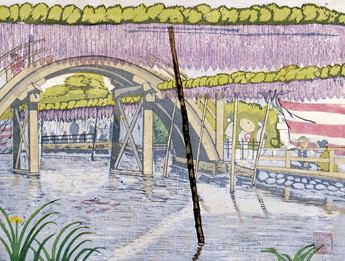 |
|
|
 29. 29. |
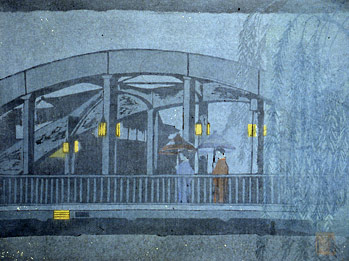 |
 “The old bridge has been replaced by a steel structure. Lights of the Kamekiyo restaurant retain a feel of past times.” “The old bridge has been replaced by a steel structure. Lights of the Kamekiyo restaurant retain a feel of past times.”
Yanagi Bridge in the Night Rain (#29), June 1932 |
|
|
 30. 30. |
  “The bridge connects Seido and the Nikolai Cathedral. A duet of bridges.”
“The bridge connects Seido and the Nikolai Cathedral. A duet of bridges.”
Anamori Inari Shrine at Haneda
(#30), September 1932 |
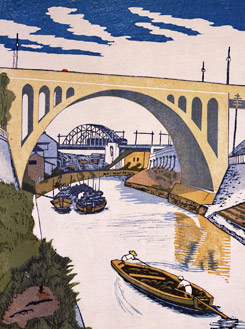
| |
|
 31. 31. |
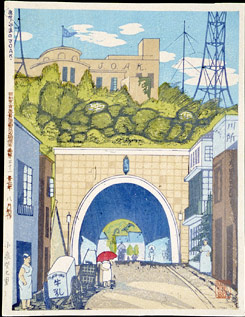
|
 “The JOAK broadcasting center has now moved to Marunouchi. They say that Atagoyama was built from the dirt excavated when the castle moat was constructed.” “The JOAK broadcasting center has now moved to Marunouchi. They say that Atagoyama was built from the dirt excavated when the castle moat was constructed.”
Broadcasting Station at Atagoyama
(#31), August 1932 |
|
|
 32. 32. |
  “On the way home from shell gathering and fishing this is a good place to take a brief rest.”
“On the way home from shell gathering and fishing this is a good place to take a brief rest.”
Anamori Inari Shrine at Haneda
(#32a), September 1932 |
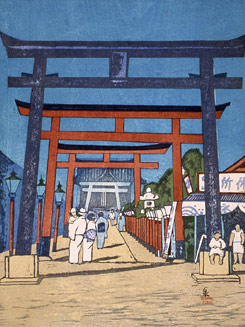 |
|
|
 33. 33. |
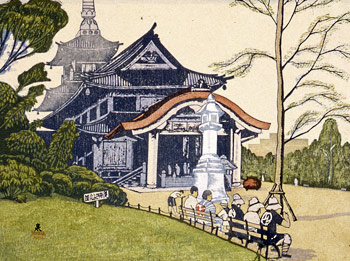 |
 “This memorial to the tragedy of September 1, 1923 is always filled with people.” “This memorial to the tragedy of September 1, 1923 is always filled with people.”
Memorial Hall for the Great Earthquake
(#33a), September 1932 |
|
|
 34. 34. |
  “In olden times cultured literati frequented this site in the autumn. Now it is operated by the city and has deteriorated.”
“In olden times cultured literati frequented this site in the autumn. Now it is operated by the city and has deteriorated.”
Hyakkaen Park at Mokoujima
(#34), October 1932 |
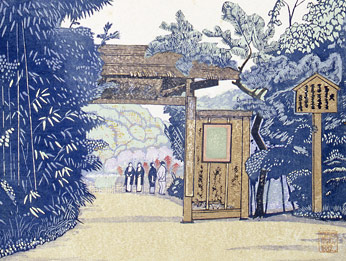 |
|
|
 35. 35. |
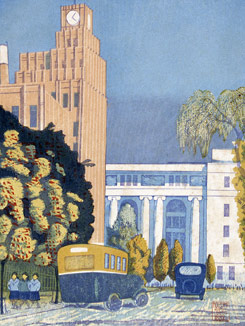 |
 “On the left is the Municipal Hall and the white stone building is the Kangyo bank.” “On the left is the Municipal Hall and the white stone building is the Kangyo bank.”
Municipal Hall and Kangyoø Bank
(#35), October 1932 |
|
|
 36. 36. |
  “Affectionately known to the locals as ‘Otori san’ this festival features good luck rakes. Every year the rakes seem to get larger.”
“Affectionately known to the locals as ‘Otori san’ this festival features good luck rakes. Every year the rakes seem to get larger.”
Asakusa Tori-no-Ichi Festival
(#36r), September 1940
Asakusa Tori-No-Ichi Festival [Oøtori
Shrine] (#36), November 1932 |
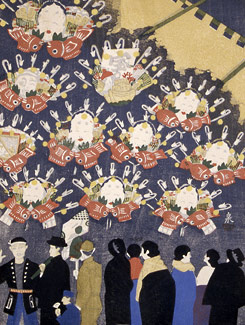
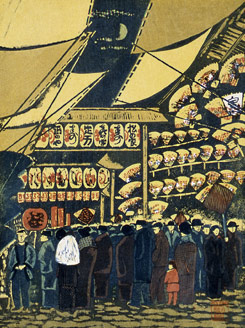
|
|
|
 37. 37. |
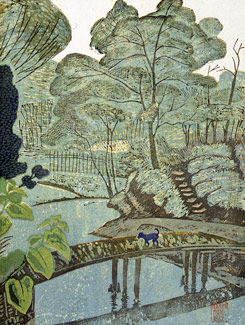
|
 “Below the temple, the banks of the Otonashi River are especially peaceful” “Below the temple, the banks of the Otonashi River are especially peaceful”
Taki River and Otonashi River at
Koøngoji Temple (#37), December 1932 |
|
|
 38. 38. |
  “The kusamochi (mugwort rice cake) at the teahouse was delicious. The metal netting covering the temple gate is unusual.”
“The kusamochi (mugwort rice cake) at the teahouse was delicious. The metal netting covering the temple gate is unusual.”
Temple to Taishaku at Shibamata
(#38), May 1933 [June 1933] |
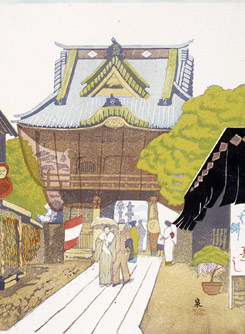
|
|
|
 39. 39. |
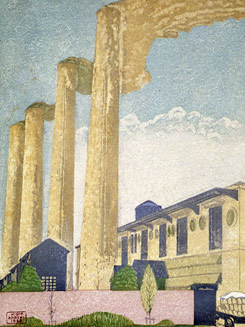 |
 “I had heard that foul smelling smoke was being emitted from this facility and went to see for myself. Actually, the chimneys are quite beautiful.” “I had heard that foul smelling smoke was being emitted from this facility and went to see for myself. Actually, the chimneys are quite beautiful.”
Fukagawa Garbage Treatment
Facility (#39), June 1933 |
|
|
 40. 40. |
  “Because this area was recently incorporated into Tokyo, degradation of this beautiful site can be expected. Like Inogashira Park, this is a good place for hiking”
“Because this area was recently incorporated into Tokyo, degradation of this beautiful site can be expected. Like Inogashira Park, this is a good place for hiking”
By the Pond of Sanpoøji Temple
at Shakuji (#40), July 1933 |
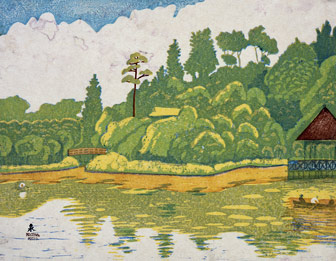 |
|
|
 41. 41. |
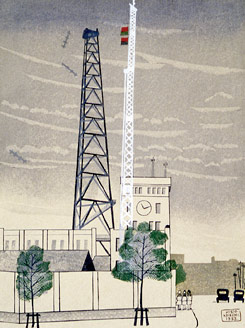 |
 “This is the place where they forecast the weather, sometimes correctly and sometimes not.” “This is the place where they forecast the weather, sometimes correctly and sometimes not.”
The Central Meteorological Observatory
(#41), September 1933 |
|
|
 42. 42. |
  “This is the burial place of Lord Ii who was killed at Sakuradamon. It is also famous for a literal mountain of cat statues.”
“This is the burial place of Lord Ii who was killed at Sakuradamon. It is also famous for a literal mountain of cat statues.”
Goøtokuji Temple at Setagaya
Ward (#42a), October 1933 |
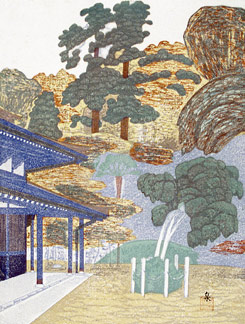
| |
|
 43. 43. |
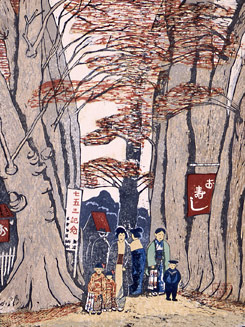
|
 “There are no longer the souvenirs of straw-made horned owls or grilled sparrow. The stately trees that line the roadway are the only reminder of the past.” “There are no longer the souvenirs of straw-made horned owls or grilled sparrow. The stately trees that line the roadway are the only reminder of the past.”
Hackberry Tree-lined Road at Kishibojin Shrine at
Toshima Ward [Zoshigaya] (#43a), November 1933 |
|
|
 44. 44. |
  “This is the celebration of the birth of the Crown Prince. An airplane is in the sky and the flower bedecked train cars cross the bridge. It has been a long time since we’ve seen those trains.”
“This is the celebration of the birth of the Crown Prince. An airplane is in the sky and the flower bedecked train cars cross the bridge. It has been a long time since we’ve seen those trains.”
Nihon Bridge on a Holiday (#44), January 1934 |
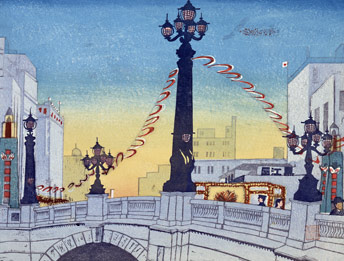
|
|
|
 45. 45. |
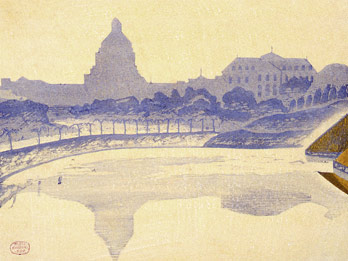 |
 “Late on a winter’s day the new diet building shimmers like a mirage in a golden haze.” “Late on a winter’s day the new diet building shimmers like a mirage in a golden haze.”
The New Diet Building (#45), February 1934 |
|
|
 46. 46. |
  “The stunning façade of the Kabukiza. Red signs naming the actors add luster to the entrance.”
“The stunning façade of the Kabukiza. Red signs naming the actors add luster to the entrance.”
Night View of the Kabuki Theatre
(#46), February 1934 |
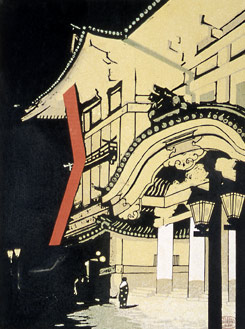 |
|
|
 47. 47. |
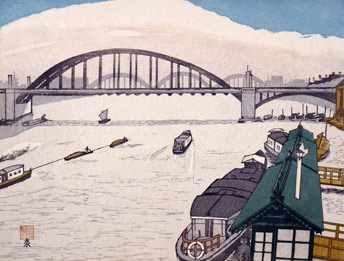 |
 “A view from Azuma Bridge on the Sumida River. Looking from one bridge to the next. A modern view.” “A view from Azuma Bridge on the Sumida River. Looking from one bridge to the next. A modern view.”
Komagata Bridge and Steamer
Terminal (#47), March 1934 |
|
|
 48. 48. |
  “Although it was too early for flower blossoms, it was a warm day. The giraffe came out and attracted a crowd.”
“Although it was too early for flower blossoms, it was a warm day. The giraffe came out and attracted a crowd.”
Zoo in Spring (#48), March 1934 |
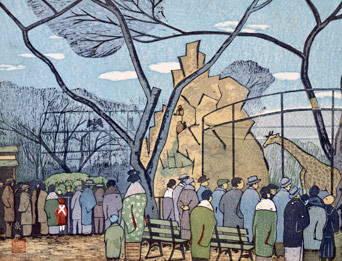 | |
|
 49. 49. |
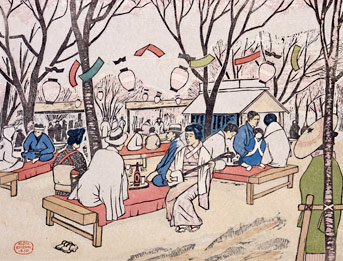
|
 “With the planting of new cherry trees, Asuka Mountain takes on the look of a modern park.” “With the planting of new cherry trees, Asuka Mountain takes on the look of a modern park.”
Cherry Blossom Viewing Party at
Asuka Mountain (#49), April 1934 |
|
|
 50. 50. |
  “This row of cherry trees is recalled in a famous play. In autumn chrysanthemums along the roadside.”
“This row of cherry trees is recalled in a famous play. In autumn chrysanthemums along the roadside.”
Night View of Cherry Blossoms at New
Yoshiwara
Center Street (#50a), April 1934 |
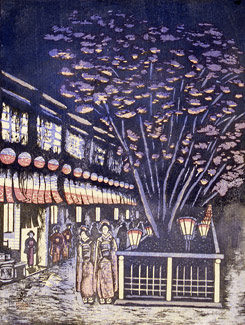 |
|
|
 51. 51. |
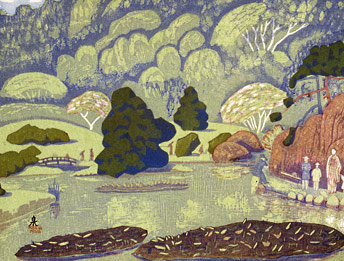
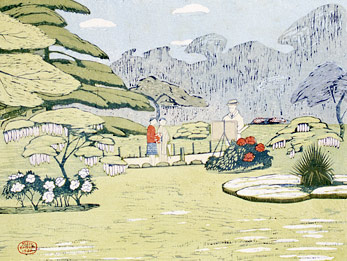 |
 “This was the former medicinal herb garden of the Tokugawa shogunate. Now it is part of the botany department at Tokyo Imperial University.” “This was the former medicinal herb garden of the Tokugawa shogunate. Now it is part of the botany department at Tokyo Imperial University.”
View of the Botanical Garden
(#51r), October 1940
The Botanical Garden in May
(#51), May 1934 |
|
|
 52. 52. |
  “This place has the appearance of a palace in a fairy tale. The ruler of Manchuko stayed here twice.”
“This place has the appearance of a palace in a fairy tale. The ruler of Manchuko stayed here twice.”
Detached Palace [Akasaka] (Formerly
Palace of Crown Prince) (#52), June 1934 |
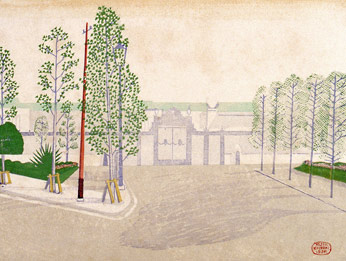 |
|
|
 53. 53. |
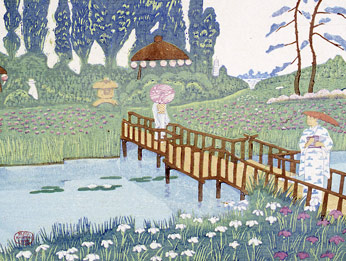 |
 “There are several iris gardens similar to this in the neighborhood. Many visitors flock here May and June.” “There are several iris gardens similar to this in the neighborhood. Many visitors flock here May and June.”
Irises at Horikiri (#53), June 1934 |
|
|
 54. 54. |
  “Jōtō Ward is an industrial area. This is in the vicinity of the gas company.”
“Jōtō Ward is an industrial area. This is in the vicinity of the gas company.”
View of Sunamachi [Jōtō Ward]
(#54), July 1934 [June 1934]0 |
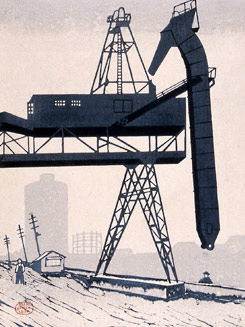
| |
|
 55. 55. |
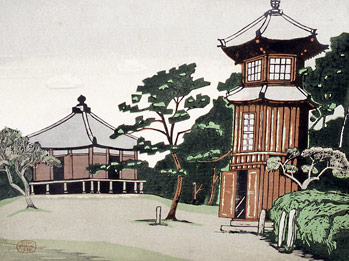
|
 “At this place the four great saints are honored and one feels the spirits researched by Professor Inoue.” “At this place the four great saints are honored and one feels the spirits researched by Professor Inoue.”
Tetsugakudoø Temple at Nakano
Ward
(#55), September 1934 |
|
|
 56. 56. |
  “The tower of Okuma Hall stands proudly over the surrounding campus.”
“The tower of Okuma Hall stands proudly over the surrounding campus.”
Waseda University Street
Scene (#56), October 1934 |
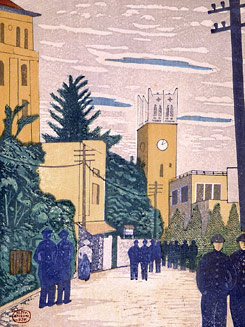 |
|
|
 57. 57. |
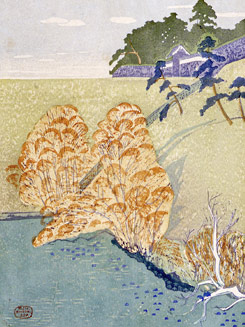 |
 “This section of the moat is beautiful in any season, but it is especially wonderful in the autumn.” “This section of the moat is beautiful in any season, but it is especially wonderful in the autumn.”
Fall Color at Hanzoø Gate
(#57),
November 1934 [October 1934] |
|
|
 58. 58. |
  “The national flower is proudly displayed in the exhibition.”
“The national flower is proudly displayed in the exhibition.”
Exhibition of Chrysanthemums of Tokyo
at Hibiya Park (#58), November 1934 |
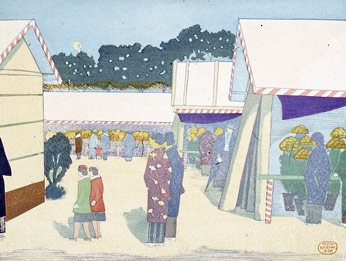 |
|
|
 59. 59. |
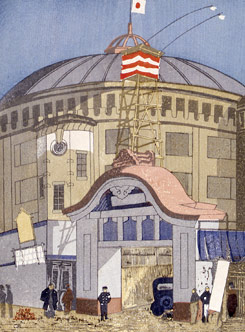
|
 “The Spring Tournament is held here in January and the Summer Tournament in May. The wrestler Futabayama is at the top of his game.” “The Spring Tournament is held here in January and the Summer Tournament in May. The wrestler Futabayama is at the top of his game.”
Spring Sumo Tournament at Kokugikan
Arena (#59), January 1935 |
|
|
 60. 60. |
  “Clustered along ‘newspaper row’ with the Asahi newspaper and the Hochi newspaper are the Nichigeki and Toho theatres.”
“Clustered along ‘newspaper row’ with the Asahi newspaper and the Hochi newspaper are the Nichigeki and Toho theatres.”
Riverside at Sukiya Bridge (#60), February 1935 |
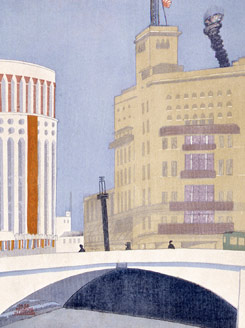 |
|
|
 61. 61. |
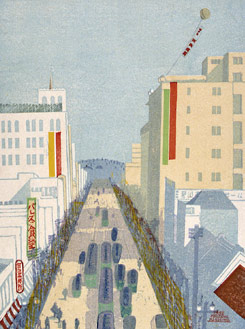 |
 “Yodobashi, Suginami and Nakano are the fashionable places for the intellectual class to gather.” “Yodobashi, Suginami and Nakano are the fashionable places for the intellectual class to gather.”
Street at Shinjuku (#61), April 1935 |
|
|
 62. 62. |
  “This garden was created from property donated the city by Prince Takamatsu. It somehow offers a slight sense of being deep in the mountains.”
“This garden was created from property donated the city by Prince Takamatsu. It somehow offers a slight sense of being deep in the mountains.”
Prince Arisugawa Memorial Park
[Azabu Ward] (#62), May 1935 |
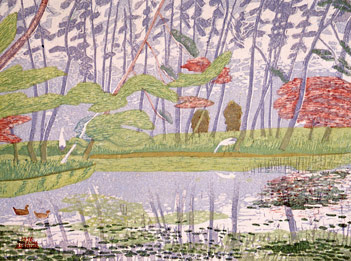 |
|
|
 63. 63. |
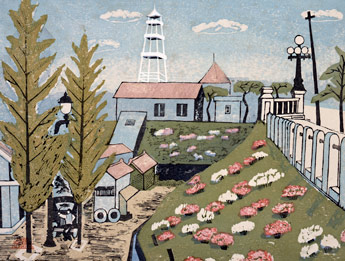 |
 “At Yotsuya Mitsuke the azaleas are beautiful. The watchtower of the fire department is a real period piece.” “At Yotsuya Mitsuke the azaleas are beautiful. The watchtower of the fire department is a real period piece.”
Azaleas at Yotsuya Mitsuke (#63), May 1935 |
|
|
 64. 64. |
  “This pine tree has the beauty of a cultivated bonsai plant. It is about 110 feet. The name of the tree comes from a legend.”
“This pine tree has the beauty of a cultivated bonsai plant. It is about 110 feet. The name of the tree comes from a legend.”
Falling Star Pine Tree at Zenyoøji
Temple (#64), June 1935 |
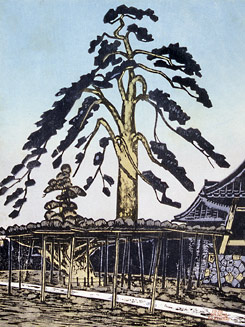
| |
|
 65. 65. |
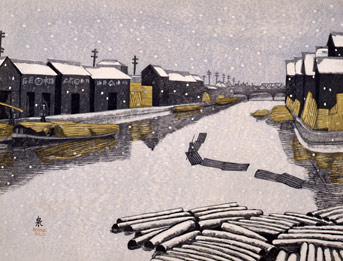
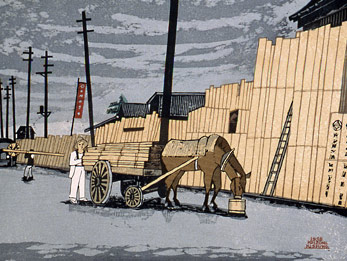 |
 “As if we didn’t have enough, last night’s snow continues to fall lightly.” “As if we didn’t have enough, last night’s snow continues to fall lightly.”
Lumberyards at Kiba in the Snow
(#65r), February 1940
Lumberyards at Kiba (#65), July 1935 |
|
|
 66. 66. |
  “The ukiyo-e tradition of depicting fireworks at this site continues uninterrupted.”
“The ukiyo-e tradition of depicting fireworks at this site continues uninterrupted.”
The River Festival at Ryoøgoku
(#66a), July 1935 |
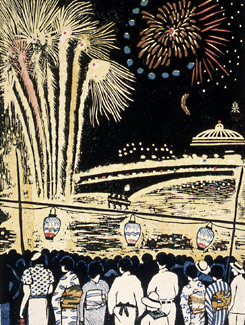 |
|
|
 67. 67. |
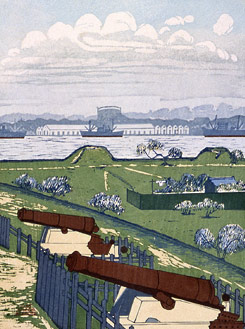 |
 “The shogunate ordered the building of this fortification after being surprised by the arrival of the ‘black ships.’” “The shogunate ordered the building of this fortification after being surprised by the arrival of the ‘black ships.’”
Battery at Shinagawa (Fort in
Edo Era) (#67), August 1935 |
|
|
 68. 68. |
  “After experiencing flooding many times, people are relieved to have this protection.”
“After experiencing flooding many times, people are relieved to have this protection.”
Lock Gate of a Drainage Canal
[Oøji Ward] (#68), August 1935 |
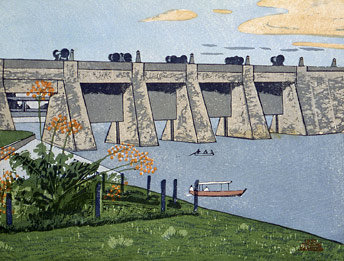 |
|
|
 69. 69. |
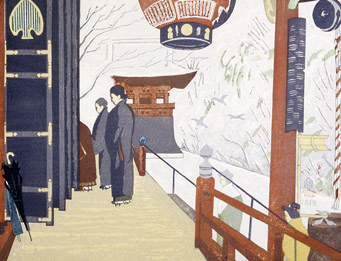
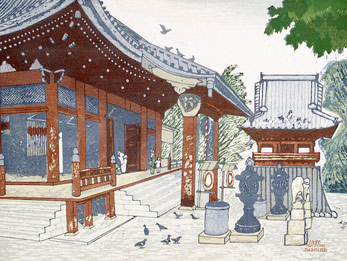 |
 “The main hall of the Fudo Temple has been beautifully renovated and the temples have been expanded.” “The main hall of the Fudo Temple has been beautifully renovated and the temples have been expanded.”
Snow View of Fudoø-doø Temple at Meguro
(#69r), February 1939 [March 1939]
Fudoø-doø Temple at Meguro
(#69), September 1935 |
|
|
 70. 70. |
  “There is a festival here on the 10th of every month. Large crowds come in the evenings and really liven up the atmosphere.”
“There is a festival here on the 10th of every month. Large crowds come in the evenings and really liven up the atmosphere.”
Konpira Shrine [also known as Kotohira
Shrine] (#70a), October 1935 |
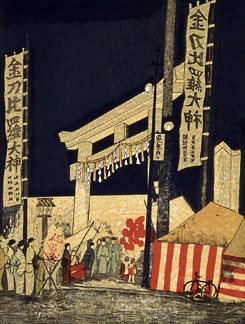
| |
|
 71. 71. |
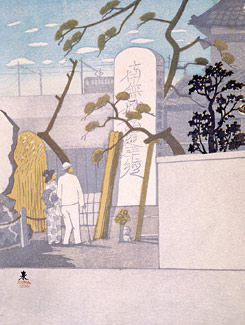
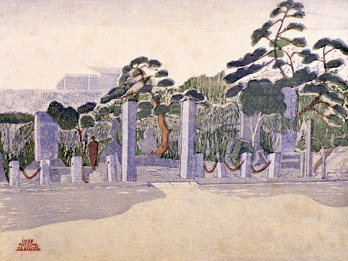 |
 “There is a large monument here. It is reproduced in a Kabuki play featuring an encounter between Chobei and Gonpachi.” “There is a large monument here. It is reproduced in a Kabuki play featuring an encounter between Chobei and Gonpachi.”
Former Execution Ground at Suzugamori
(#71r), August 1940 [March 1940]
Former Execution Ground at
Suzugamori (#71), October 1935 |
|
|
 72. 72. |
  “This is a museum dedicated to describing the life and times of the Meiji emperor through paintings.”
“This is a museum dedicated to describing the life and times of the Meiji emperor through paintings.”
Meiji Memorial Picture Gallery
(#72), November 1935 |
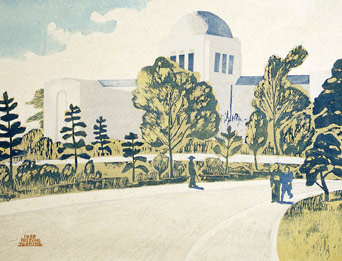 |
|
|
 73. 73. |
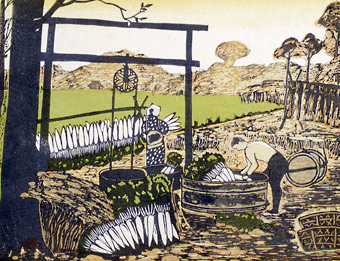 |
 “Daikon of Nerima have been renowned from the time they were presented as gifts to the shogun. The priest Takuan introduced a recipe for pickling these radishes. So they became even more famous.” “Daikon of Nerima have been renowned from the time they were presented as gifts to the shogun. The priest Takuan introduced a recipe for pickling these radishes. So they became even more famous.”
Landscape at Nerima Ward (#73), November 1935 |
|
|
 74. 74. |
  “This hagoita (battledore) festival at Kaminari Gate as well as the hagoita festival at Fukugawa Yawata are year-end events especially popular with young girls.”
“This hagoita (battledore) festival at Kaminari Gate as well as the hagoita festival at Fukugawa Yawata are year-end events especially popular with young girls.”
Hagoita [Battledore] Fair at Yawata Shrine,
Fukagawa (#74a), December 1935 |
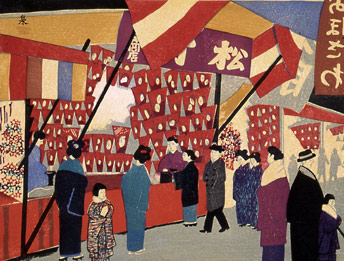 |
|
|
 75. 75. |
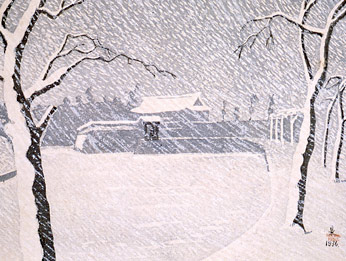 |
 “I wonder if it was snowing like this when Foreign Minister Ii was assassinated by loyal samurai from Mito?” “I wonder if it was snowing like this when Foreign Minister Ii was assassinated by loyal samurai from Mito?”
Snow at Sakurada Gate (#75a), February 1936 |
|
|
 76. 76. |
  “This has the feel of a print by Hiroshige III in which he depicted snow on a Western-style building at dusk.”
“This has the feel of a print by Hiroshige III in which he depicted snow on a Western-style building at dusk.”
Remaining Snow at Tokyo City
Hall (#76), March 1936 |
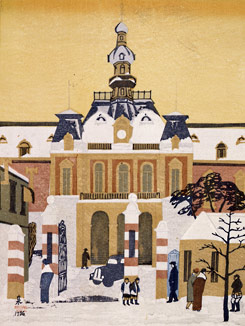
| |
|
 77. 77. |
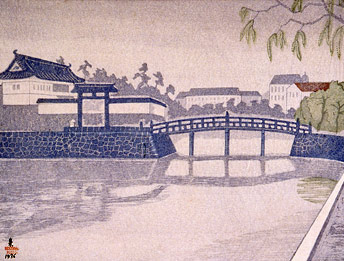
|
 “This gate is the entrance to the Imperial Household Agency. In the rain it somehow conveys the feeling of the Edo period.” “This gate is the entrance to the Imperial Household Agency. In the rain it somehow conveys the feeling of the Edo period.”
Hirakawa Gate in the Spring
Rain (#77a), April 1936 |
|
|
 78. 78. |
  “In the middle of the Yanaka cemetery stands a five-story pagoda made of plain, unpainted wood.”
“In the middle of the Yanaka cemetery stands a five-story pagoda made of plain, unpainted wood.”
Pagoda of Tennoøji Temple at Yanaka
(#78a), May 1936 [April 1936] |
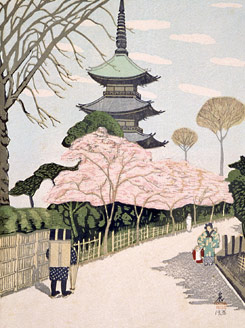 |
|
|
 79. 79. |
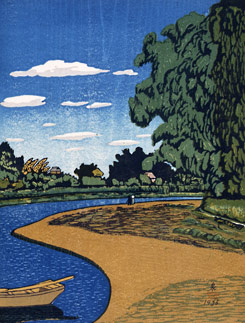 |
 “Tradition relates that the shogun Yoritomo discovered a spring at this site. The municipality has designated this place as an official scenic site.” “Tradition relates that the shogun Yoritomo discovered a spring at this site. The municipality has designated this place as an official scenic site.”
Pond at Zenpukuji Temple in
Suginami (#79), June 1936 |
|
|
 80. 80. |
  “In the old days this was a good place from which to view Mt. Tskuba. Today the sky is filled with pollution.”
“In the old days this was a good place from which to view Mt. Tskuba. Today the sky is filled with pollution.”
View from Suwa Shrine (#80a), August 1936 |
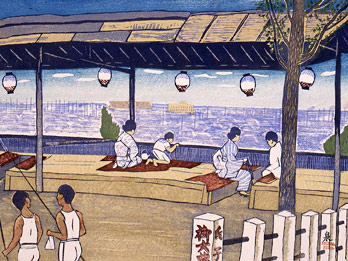 |
|
|
 81. 81. |
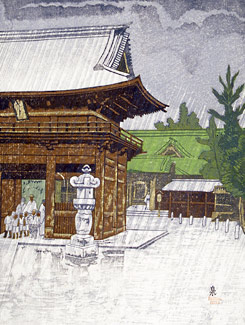 |
 “The patina on this National Treasure shrine is lovely but the temple surroundings seem lonely and poorly kept.” “The patina on this National Treasure shrine is lovely but the temple surroundings seem lonely and poorly kept.”
Shower at Nezu Shrine
(#81), September 1936 |
|
|
 82. 82. |
  “These green links fill an area of 420,000 square meters. It is a wonderful course for training.”
“These green links fill an area of 420,000 square meters. It is a wonderful course for training.”
Golf Course at Komazawa
(#82), September 1936 |
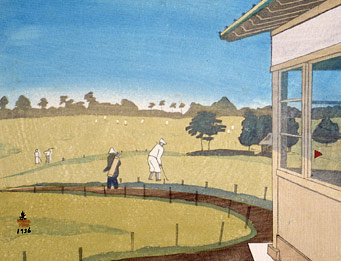
| |
|
 83. 83. |
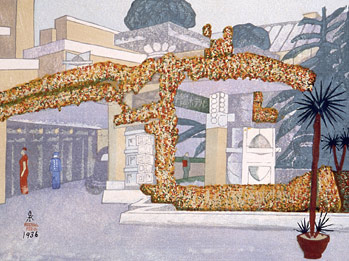
|
 “This hotel serves an international and cosmopolitan clientele as well as being a social club for the elite.” “This hotel serves an international and cosmopolitan clientele as well as being a social club for the elite.”
Entrance of the Imperial Hotel (#83),
October 1936 [November 1936] |
|
|
 84. 84. |
  “This post office process mail from all over the world. The station sees the comings and goings of both domestic and international travelers.”
“This post office process mail from all over the world. The station sees the comings and goings of both domestic and international travelers.”
Tokyo Station and the Central Post
Office (#84), November 1936 |
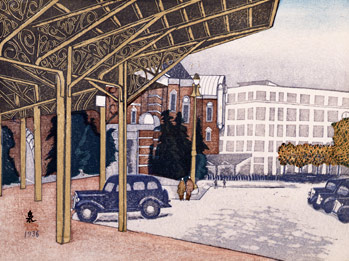 |
|
|
 85. 85. |
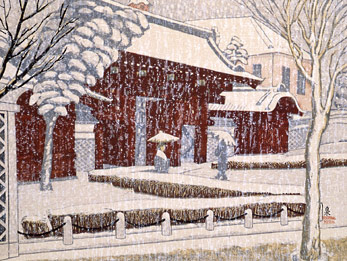 |
 “This gate formerly protected the residence of the consort of the Kaga daimyo. Large, wet snowflakes fall. The gate is a national treasure.” “This gate formerly protected the residence of the consort of the Kaga daimyo. Large, wet snowflakes fall. The gate is a national treasure.”
Snow on Akamon Gate, Tokyo Imperial
University (#85), December 1936 |
|
|
 86. 86. |
  “Asakusa seaweed, a famous Tokyo product, is harvested and prepared on the coast line from Omori to Haneda.”
“Asakusa seaweed, a famous Tokyo product, is harvested and prepared on the coast line from Omori to Haneda.”
Drying Seaweed at Omori (#86), February 1937
|
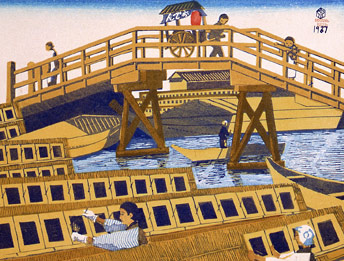 |
|
|
 87. 87. |
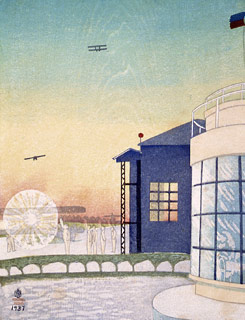 |
 “This is a terminal for airplanes. The day is approaching when people from all over the world will come here freely.” “This is a terminal for airplanes. The day is approaching when people from all over the world will come here freely.”
Tokyo International Airport at
Haneda (#87), March 1937 |
|
|
 88. 88. |
  “The subway station is located adjacent to the department store. The station is decorated with artificial flowers to greet customers.”
“The subway station is located adjacent to the department store. The station is decorated with artificial flowers to greet customers.”
Subway in Spring (#88), 1937 |
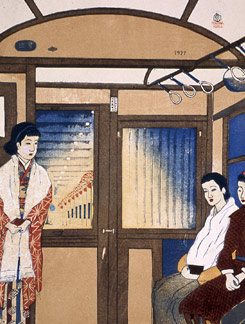
| |
|
 89. 89. |
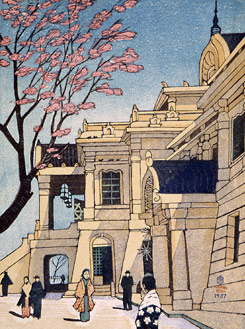
|
 “This temple is built in the style of Buddhist architecture so that the Buddha won’t become homesick.” “This temple is built in the style of Buddhist architecture so that the Buddha won’t become homesick.”
Cherry Blossoms at Tsukiji Honganji
Temple (#89), April 1937 |
|
|
 90. 90. |
  “In the spring, Ueno is filled with beautiful flowers. The zoo, art museums and general museums are all very good.”
“In the spring, Ueno is filled with beautiful flowers. The zoo, art museums and general museums are all very good.”
Museums in Spring Color (#90), April 1937 |
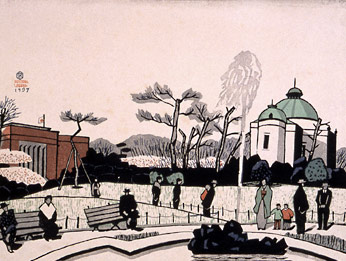 |
|
|
 91. 91. |
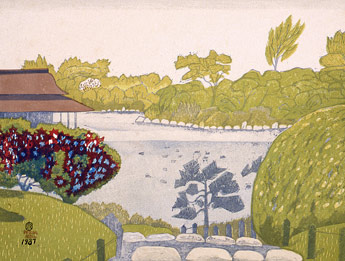 |
 “This garden is the pride of City Hall and foreign guests are often invited there for tea.” “This garden is the pride of City Hall and foreign guests are often invited there for tea.”
Kiyosumi Garden in Fukagawa (#91), May 1937 |
|
|
 92. 92. |
  “In Tokyo there are a number of temples designated as national treasures. This is one.”
“In Tokyo there are a number of temples designated as national treasures. This is one.”
Gokokuji Temple in Koishikawa (#92), May 1937 |
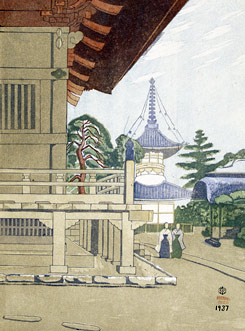 |
|
|
 93. 93. |
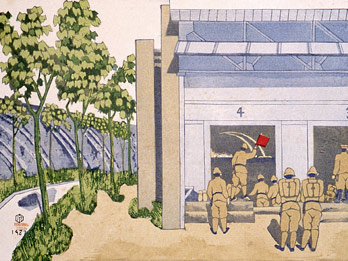 |
 “This is where the elite imperial forces are trained. The sound of live fire is thrilling.” “This is where the elite imperial forces are trained. The sound of live fire is thrilling.”
Army Firing Range in the Fields of
Toyama [Oøkubo] (#93), June 1937 |
|
|
 94. 94. |
  “It is said that the monk Nichiren washed his feet at this pond. This is a view from the second floor of the boat house.”
“It is said that the monk Nichiren washed his feet at this pond. This is a view from the second floor of the boat house.”
Rainy View of Senzoku Pond
(Rainy Season) (#94), July 1937 |
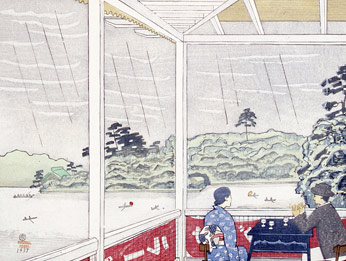 |
|
|
 95. 95. |
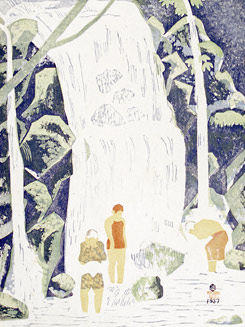
|
 “From olden times this was a place where people went to show off their tattoos.” “From olden times this was a place where people went to show off their tattoos.”
Nanushi Waterfall at Oøji (#95),
1937 [August 1937] |
|
|
 96. 96. |
  “The city planners built an elevated highway to eliminate stops at the train crossing, but pedestrians still wait.”
“The city planners built an elevated highway to eliminate stops at the train crossing, but pedestrians still wait.”
Suehiro Street in Senju (#96), August 1937 |
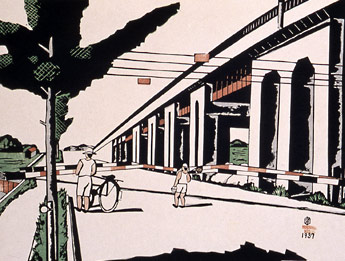
|
|
|
 97. 97. |
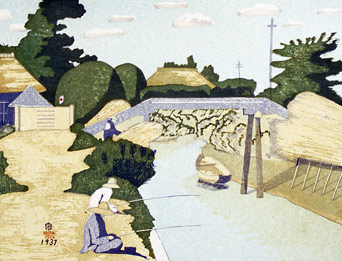 |
 “A small stream meanders. From the embankment anglers are intent on landing small fish.” “A small stream meanders. From the embankment anglers are intent on landing small fish.”
Horie-Machi in Kasai (#97), September 1937 |
|
|
 98. 98. |
  “For 300 years, the fish market was at
“For 300 years, the fish market was at
Nihon Bridge. Now the market is
located at Tsukiji.”
Tsukiji Fish Market (#98), October 1937 |
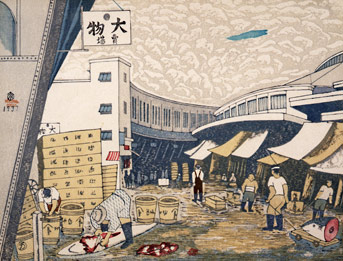 |
|
|
 99. 99. |
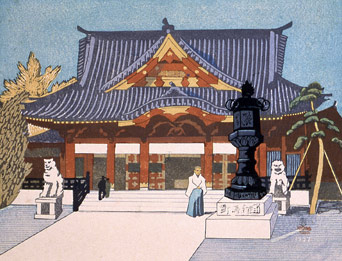 |
 “To the west, Sanno Shrine. To the east, Myojin. The festivals at these shrines were once the pride of Edo.” “To the west, Sanno Shrine. To the east, Myojin. The festivals at these shrines were once the pride of Edo.”
Kanda Myoøjin Shrine (#99), November 1937 |
|
|
100. |
  “Finances of the world are
“Finances of the world are
managed in this market.”
Stock Exchange at Kabuto-choø
(#100), December 1937 |
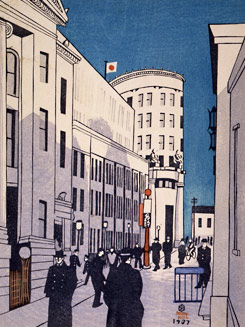
| |
|

